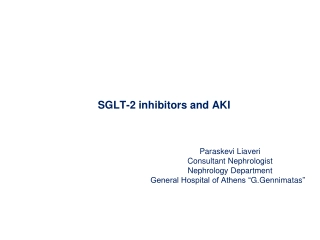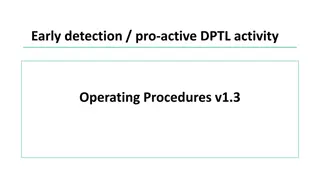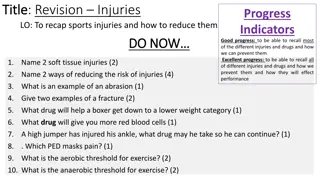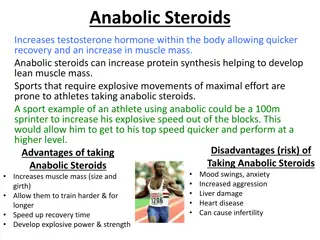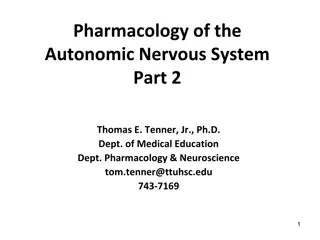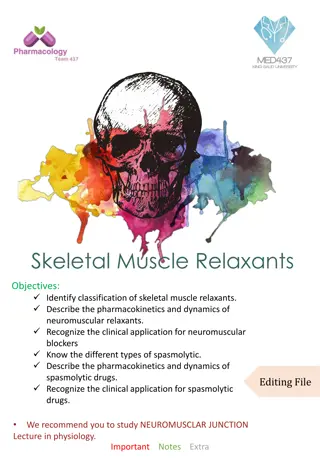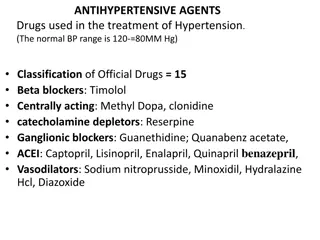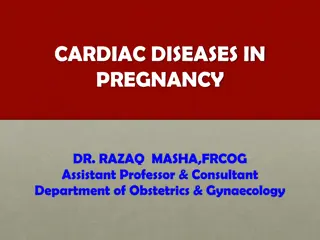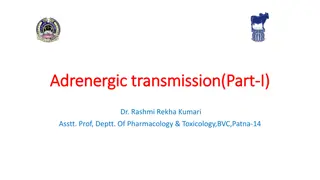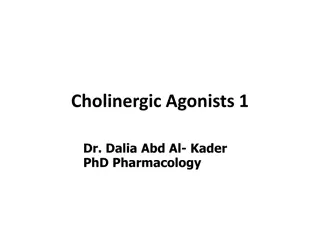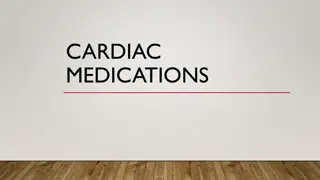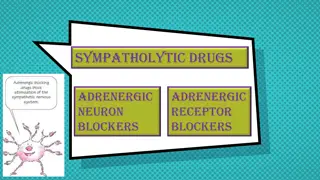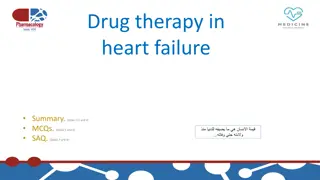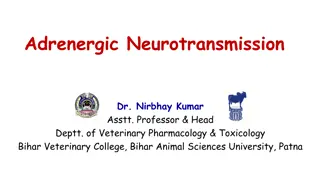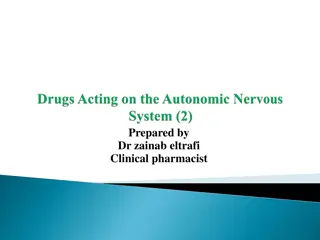SGLT-2 inhibitors and AKI
Consultant Nephrologist Paraskevi Liaveri discusses the association between SGLT-2 inhibitors and acute kidney injury (AKI). Pharmacovigilance reports highlight a higher risk of AKI with these drugs, especially when combined with RAAS blockers, diuretics, or NSAIDs. Studies suggest potential mechani
0 views • 49 slides
Understanding Adrenergic Agents in Pharmaceutical Chemistry
Adrenergic agents play a crucial role in pharmacology by influencing the sympathetic nervous system through adrenergic receptors. These agents, such as sympathomimetics and sympatholytics, impact essential functions like cardiac activity, blood vessel dilation, and insulin release. Adrenergic neurot
0 views • 120 slides
Overview of Antiarrhythmic Drugs Use and Classification
Antiarrhythmic drugs are classified into different classes based on their mechanisms of action. Class I includes sodium channel blockers with specific drugs like procainamide, disopyramide, and quinidine. Class 1B involves lidocaine and mexiletine. Class 1C consists of agents like flecainide. Class
2 views • 19 slides
Early Detection and Proactive DPTL Activity Operating Procedures
Coordinated multi-disciplinary team efforts are crucial in preparing patients for discharge promptly to avoid prolonged hospital stays. Early detection and proactive DPTL activity focus on identifying potential discharge obstacles as soon as patients arrive in the emergency department. Various commo
5 views • 13 slides
Managing Sports Injuries: Prevention and Treatment Strategies
This content covers various sports injuries, ways to reduce risks, treatment of injuries including R.I.C.E method, and different drugs used in sports like anabolic steroids, beta blockers, peptide hormones, and the concept of blood doping. It also touches upon benefits, risks, and examples related t
0 views • 11 slides
Performance-Enhancing Drugs in Sports: Types and Effects
Anabolic steroids, beta-blockers, diuretics, narcotic analgesics, and peptide hormones are commonly used in sports to enhance performance. Each drug has specific advantages and disadvantages, impacting athletes' physical and mental health. While some drugs enhance muscle growth and speed up recovery
0 views • 8 slides
Pharmacology of the Autonomic Nervous System Part 2 Summary and Learning Objectives
Explore the pharmacology of the autonomic nervous system focusing on cholinergic and adrenergic agents. Learn about cholinomimetics, direct and indirect acting cholinergic agonists, their therapeutic indications, and adverse effects. Discover the mechanism of action and uses of nicotinic agonists. D
1 views • 44 slides
Skeletal Muscle Relaxants: Classification, Pharmacokinetics, and Clinical Applications
Skeletal muscle relaxants encompass different types, including neuromuscular blockers, spasmolytic drugs, and peripherally-acting agents. They are classified based on mechanisms of action and play crucial roles in inducing skeletal muscle relaxation for various clinical applications. Understanding t
3 views • 12 slides
Overview of Antihypertensive Agents and their Mechanisms of Action
Explore the classification of antihypertensive agents used in treating hypertension, including beta blockers, centrally acting agents, ganglionic blockers, ACE inhibitors, vasodilators, and more. Learn about the Renin-Angiotensin System, ACE inhibitors, and specific drugs like Captopril and Benazepr
0 views • 9 slides
Overview of Anxiety Disorders and Antianxiety Drugs
Anxiety disorders are conditions characterized by excessive worry and fear that can interfere with daily life. Common types include generalized anxiety disorder, panic disorder, phobias, and OCD. Treatment options include psychotherapy and anxiolytic drugs such as benzodiazepines, 5HT1A agonists, be
0 views • 25 slides
Cardiac Diseases in Pregnancy: Implications and Management
Normal pregnancy induces significant physiologic changes in the cardiovascular system, which can impact women with pre-existing cardiac diseases. Understanding the New York Heart Association classification scheme is crucial for assessing symptomatology during pregnancy. Rheumatic Heart Disease, part
0 views • 12 slides
Understanding Adrenergic Transmission and Catecholamine Synthesis
Adrenergic transmission involves the release of neurotransmitters such as norepinephrine, dopamine, and epinephrine at synapses or neuroeffector junctions. These neurotransmitters, known as catecholamines, play crucial roles in transmitting impulses in the sympathetic nervous system and central nerv
0 views • 14 slides
Understanding Cholinergic Neurons and Agonists in Pharmacology
Cholinergic neurons play a vital role in neurotransmission by utilizing acetylcholine (ACh) as a neurotransmitter. This neurotransmission involves steps like synthesis, storage in vesicles, release, receptor binding, degradation, and recycling of choline and acetate. Choline acetyltransferase cataly
0 views • 30 slides
Overview of Cardiac Medications and Their Effects
This comprehensive guide covers various types of cardiac medications including anticoagulants, antiplatelet drugs, thrombolytics, and beta-blockers. It details their mechanisms of action, dosage guidelines, side effects, and contraindications. Anticoagulants prevent blood clotting, antiplatelets inh
0 views • 20 slides
Understanding Adrenergic Neuron Blockers: Mechanisms and Pharmacological Effects
Explore the mechanisms of action of adrenergic neuron blockers and classify adrenergic receptor blockers into selective and non-selective categories. Delve into the pharmacokinetic aspects and pharmacodynamic effects of these blockers, such as false transmitter formation, store depletion, release in
0 views • 29 slides
Pharmacotherapy for Heart Failure: A Comprehensive Review
In heart failure management, drugs play a crucial role in reducing preload and afterload, increasing cardiac contractility, and improving overall outcomes. Common drug classes include diuretics, aldosterone antagonists, ACE inhibitors, ARBs, beta-blockers, and vasodilators. These medications help al
0 views • 8 slides
Computer Forensics: Capturing and Verifying Evidence
This guide focuses on the process of capturing and verifying digital evidence in computer forensics. Topics include creating forensic images of hard drives, using forensically sound methods, imaging internal hard drives, utilizing hardware write blockers, different types of forensic images, hashing
0 views • 28 slides
Optimizing Foundational Treatments for HFrEF: Guideline Recommendations and Implementation Strategies
Highlighting the current guideline recommendations for treating patients with Heart Failure with Reduced Ejection Fraction (HFrEF), this educational slide module emphasizes the importance of implementing the recommended therapies effectively. It covers the foundational treatments recommended by vari
0 views • 28 slides
Enhancing Reflective Practice: Understanding, Application, and Importance
Explore the concept of reflection through Johns' perspective, understanding its levels, benefits, and challenges. Discover how reflective practice empowers practitioners to enhance learning, development, and patient care quality. Identify blockers to reflection and strategies to overcome them.
0 views • 12 slides
Understanding Pharmacology: Introduction to Neurotransmitters and Nervous System
This content delves into the fundamentals of neuropharmacology, exploring concepts such as dose-response curves, afferent and efferent neurons, peripheral nervous system divisions, neurotransmitter functions, and neurochemical classifications. It covers the roles of cholinergic, adrenergic, and dopa
0 views • 29 slides
Understanding Adrenergic Neurotransmission in Veterinary Pharmacology
Adrenergic neurotransmission, mediated by norepinephrine, dopamine, and epinephrine, plays a crucial role in various physiological processes. This process involves synthesis, storage, release, and termination of catecholamines like norepinephrine and epinephrine. The intricate mechanisms of neurotra
0 views • 12 slides
**Understanding Portal Hypertension: Causes, Symptoms, and Treatment**
Portal hypertension is a serious condition often associated with cirrhosis. Causes include cirrhosis and non-cirrhotic conditions. Symptoms range from asymptomatic to complications like variceal hemorrhage, ascites, and splenomegaly. Preventive measures, such as nonselective beta-blockers, are cruci
0 views • 14 slides
Understanding Skeletal Muscle Relaxants and Muscle Contraction Mechanisms
Skeletal muscle relaxants play a crucial role in relaxing muscles without affecting consciousness significantly. They are classified into neuromuscular blockers and spasmolytics, each targeting different mechanisms in the body. Muscle contraction occurs through the release of acetylcholine and the s
0 views • 27 slides
Understanding Adrenergic Agonists and Their Classification
Sympathomimetic amines like epinephrine, norepinephrine, isoproterenol, and dopamine are catecholamines with high potency but poor CNS penetration. Noncatecholamines like phenylephrine and ephedrine have longer half-lives. Learn about direct-acting, indirect-acting, and mixed-action adrenergic agoni
0 views • 25 slides
Overview of Skeletal Muscle Relaxants and Neuromuscular Blockers
Skeletal muscle relaxants and neuromuscular blockers are important drugs used to induce muscle relaxation. They are classified based on their site of action and mechanism of action. Understanding their classification, pharmacokinetics, and clinical applications is crucial for medical professionals.
0 views • 25 slides
Debugging Blocker in Entity Matching using MatchCatcher
Explore how the MatchCatcher solution helps identify and improve matches killed off by blockers in the entity matching process. The solution allows users to quickly find and analyze these matches, enhancing the efficiency of the blocking stage in entity matching.
0 views • 24 slides
Rational Management of Metastatic Castration-Resistant Prostate Cancer: Treatment Insights and Options
Experts discussed various treatment options for a 60-year-old patient with mCRPC, including switching to Lutetium therapy after progression on Apalutamide. Genetic testing, avoiding back-to-back hormonal therapies, and considering novel AR-blockers like Lutetium-PSMA and PARP inhibitors were highlig
0 views • 6 slides
Management of Benign Prostatic Hyperplasia (BPH) in Men: Diagnosis and Treatment Guidelines
Benign Prostatic Hyperplasia (BPH) is a common urological problem in men, especially those over 45 years old. This article discusses the diagnosis and management of BPH, including symptoms, impact on quality of life, diagnostic steps, lifestyle modifications, medication options like alpha blockers a
1 views • 15 slides
